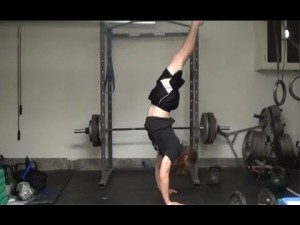The following is an excerpt from Practicing Strength and Movement: How to Gain Any Skill FASTER! which is the new manual now available.
In working around the idea of “strength is a skill” I came up with the following continuum. Previously I have pointed out the difference between training and testing your strength, but here the third element of practice is added.
<—– Practicing —– Training —– Testing —–>
In practicing you’re primary aim is to build up your skill level in what you’re doing.
In training you’re focus is more on the physical components whether that is building muscle, gaining strength, gaining flexibility, etc.
In testing you are showcasing all of your ability, often towards some goal.
There is carryover between these three ideas. Its not like you’re only doing one thing and not the other. So let me give you a few examples that can clear this up. First up is the kettlebell snatch.
Example #1 – Kettlebell Snatch

Testing would involve the kettlebell snatch test, in one variation or another. Usually ten minutes trying to get as many reps as possible. It’s a feat of endurance with strength, grip and mental toughness thrown in too.
Training could involve any method designed to build those components that would eventually help with the test. One minute sprint sets for speed. A longer set with a lighter weight for more endurance. Using a heavier weight for more strength.
Practicing could be working on the technique in order to fine tune it. Just because you have “good technique” doesn’t mean you can’t fine tune what you do to become even more efficient. You see, when you’re training, and definitely when you’re testing, you’re going to be relying on all the habits of your technique. But in practice, and this can be carried over into training through conscious awareness, you can work on changing one or more of those habits to make it even better.
Example #2 – Deadlift
 Doing a test will have a training effect for sure, but that doesn‘t mean testing is the best way to get better. In fact it seldom is. Let’s look at another example, the deadlift.
Doing a test will have a training effect for sure, but that doesn‘t mean testing is the best way to get better. In fact it seldom is. Let’s look at another example, the deadlift.
Testing would involve a max lift. It could also be a different sort of max effort like 20 reps with a heavy weight. Here there is some training effect, but it won’t necessarily be building as much new strength as if you did something different. In fact, too much testing can lead to burnout especially in something like the deadlift.
Training would usually involve several sets. It can involve working up to a max, if your prefer singles. It might be 5×5. It might be any number of other set and rep schemes. It can also be variations of the deadlift, or other supporting lifts (for example the squat can carry over to the deadlift). Training can be working on components of the lift, perhaps rack pulls or extended deadlifts.
Practice might involve making small tweaks to your form to see if you can find anything that feels and works better. It may also involve trying new forms of visualization to see what works best. Practice can also involve the analyzing of your weak points to find the exercises that will best help you, like the aforementioned rack pulls or extended deadlifts.
Example #3 – Freestanding Handstand
 And let’s use one last example, doing a freestanding handstand.
And let’s use one last example, doing a freestanding handstand.
Testing would be finding out how long you can hold it.
Training can also be holding the handstand for time, and doing sets of that, up to a total you’re working towards. You may do some things to build specific attributes you need, like wall handstand holds to build endurance. It may involve shoulder flexibility drills to help them open up more.
Practicing can focus a bit more on the components of the handstand. This is like the lead-up stunts of the frogstand, headstand, etc. which can be trained. Becoming more conscious of the elements going on and working to correct them is the mindset more of practice, rather than just training and doing holds for time. Of course, visualization and other mental drills will come into play here.
I hope these examples have made it clear. It was in realizing this three part continuum, that I added two or three days per week, just a little bit of time, to work on practicing the kettlebell snatch, in addition to the regular training I’ve been doing with it.
Want a whole lot more about practicing your strength and skills? Get Practicing Strength and Movement: How to Gain Any Skill FASTER! here…
